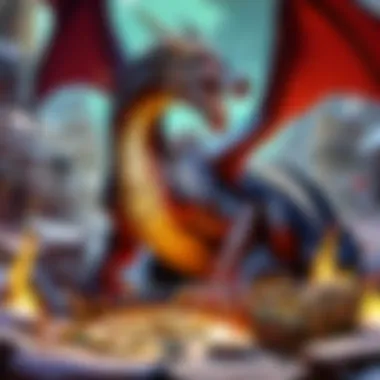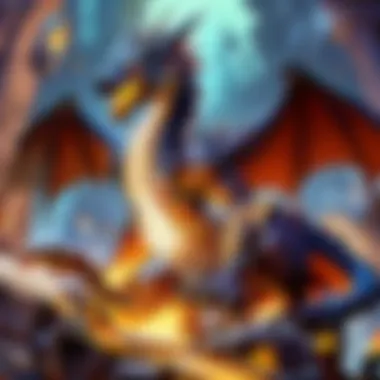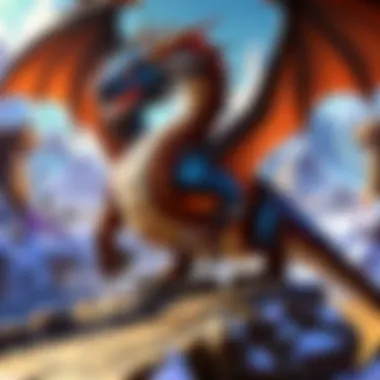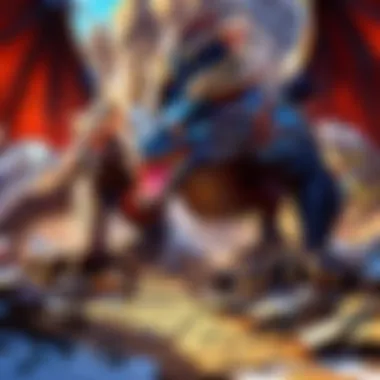Exploring the Dragon Hoard: Mythology to Gameplay


Intro
The concept of a dragon hoard evokes images of vast treasures guarded by fearsome beasts. This idea extends far beyond mere folklore. It represents rich themes tied to history, culture, and modern gaming. The intersection of these elements particularly thrives in the gaming universe of Hearthstone. Here, the dragon hoard takes on a new life, intertwining with gameplay mechanics, card design, and player strategy.
Understanding the dragon hoard requires a multifaceted approach. Historians and mythologists recognize its roots in ancient tales, wherein dragons symbolize both greed and the protective nature of wealth. As it appears in contemporary narratives, the concept shifts slightly, focusing on its role in interactive storytelling and gameplay. This article aims to unpack that complexity.
Players often relate to the dragon hoard on multiple levels. As they collect cards, make strategic decisions, and face opponents, the hoard becomes a metaphor for ambition and achievement. It embodies the aspiration to dominate the competitive gaming landscape. A thorough analysis of the dragon hoard provides insight into how these themes resonate through lore and gameplay in Hearthstone, drawing on various fields such as psychology and game design.
In the following sections, we will explore how recent game updates influence this rich theme, the strategies that emerge from it, and the importance of cards that reflect the essence of the dragon hoard.
Intro to the Dragon Hoard
The concept of the dragon hoard serves as a compelling motif in various narratives and cultural contexts. Its importance lies in the multifaceted representations of wealth, power, and desire that it encapsulates. By examining the origins and usage of the dragon hoard, one gains a deeper understanding of not just the myth itself, but also its implications in modern culture, especially in gaming and literature. This exploration reveals both individual psychology and broader societal trends centered around accumulation and loss.
Defining the Dragon Hoard
The dragon hoard typically refers to the treasure amassed by a dragon, often depicted in tales featuring these legendary creatures. This treasure includes gold, jewels, and various artifacts. More than just a physical collection, the hoard symbolizes the nature of greed and the human psyche’s fascination with material wealth. In many stories, dragons guard their hoards jealously, emphasizing the idea that such accumulation is not merely for sustenance but also for status.
The hoard can also be viewed as a narrative device—a catalyst for conflicts between humans and dragons. Heroes of these stories often face the daunting task of reclaiming these treasures, which serves to highlight their bravery or greed depending on the narrative focus. In role-playing games like Hearthstone, this concept translates into game mechanics where wealth accumulation plays a key role in strategy and gameplay.
Historical Context and Origins
The dragon hoard has roots in various cultures and mythologies. Ancient texts mention dragons and their treasures, revealing a common thread in storytelling across civilizations. For example, in Norse mythology, the dragon Fafnir is known for guarding an immense hoard of gold, illustrating themes of transformation and greed.
In medieval European tales, dragons often appear as adversaries, with their hoards as both motivation and goal for hero figures. This historical significance enriches the dragon hoard's narrative, showing how it evolved over time. The hoard represents not only a literal collection of wealth but also the moral lessons regarding ambition and consequence woven through these stories.
The intersection between culture, history, and mythology creates a complex framework for understanding the dragon hoard. As this article progresses, it will further explore how these elements manifest in modern gaming and media, particularly in the realm of Hearthstone.
Mythological Perspectives on Dragon Hoards
The examination of mythological perspectives on dragon hoards serves as a critical component in understanding the allure and significance of these legendary treasures. In mythology, dragons are often depicted as guardians of vast wealth and riches. This notion has permeated through various cultures, influencing literature, art, and even modern gaming. By exploring the mythological roots of the dragon hoard concept, we can gain valuable insights into human behaviors related to wealth accumulation, fear of loss, and the cultural significance of treasure in our collective imagination.
Dragons in Various Cultures
Dragons have captured human imagination across numerous cultures for centuries. In Western mythology, dragons are typically seen as malevolent creatures, hoarding treasures and enforcing their ownership through intimidation. Tales, such as those of Smaug from The Hobbit, illustrate this perspective. Smaug sits atop a great pile of gold, emphasizing the dragon's role as a formidable guardian of wealth.
Conversely, in Eastern cultures, dragons are often revered and symbolize wisdom, strength, and prosperity. The Chinese dragon, for example, represents auspiciousness and is associated with rainfall and agricultural success. It is often depicted as a serpent-like creature, more in harmony with nature than its Western counterparts.
This dichotomy in dragon representation illustrates how cultural values and myths shape our understanding of wealth. In many stories, quests for dragon hoards symbolize human desire for prosperity, status, and security, reflecting deep-seated emotions tied to treasure.
Symbolism of Wealth and Power
This section delves into the symbolic aspects of dragon hoards. They are not merely physical accumulations of gold and jewels; they embody deeper concepts of wealth and power in society. The dragon itself acts as a gatekeeper to these material possessions, representing the often tumultuous journey individuals undertake to attain success and riches.
In folklore, dragon hoards signify aspirations. Treasures are often portrayed as rewards for bravery, intelligence, and cunning. Characters, like heroes in many tales, must confront and overcome the dragon, symbolizing the struggle against one's fears and limitations. The act of obtaining the treasure reflects the arduous process of achieving personal or financial goals.
Moreover, dragon hoards can be interpreted as a critique of greed. In several stories, characters suffer dire consequences as a result of their excessive desires for wealth. This narrative serves as a cautionary tale about the dangers of materialism and the pursuit of riches at the expense of morality.


"In myth, dragons serve a dual purpose: they guard treasure and represent the perils of unbridled ambition."
Ultimately, the concept of dragon hoards encapsulates a range of themes relevant to wealth and power, allowing for a rich exploration that extends beyond mere fantasy. It mirrors societal values and individual ambitions. For fans of Hearthstone and similar games, recognizing these mythological origins can deepen appreciation for gameplay mechanics that incorporate dragon hoards as a central aspect.
In summary, the mythology surrounding dragon hoards offers multifaceted insights. It reflects cultural beliefs, highlights human aspirations, and warns against the pitfalls of greed. Understanding these themes enhances our grasp of not just literary and gaming narratives, but also the underlying messages we draw from them.
Psychology Behind the Dragon Hoard Concept
Understanding the psychology behind the dragon hoard concept is essential in grasping its broader cultural implications. The hoard represents not just material wealth but also human behavior related to accumulation and the emotional connections tied to possessions. This section delves into two primary aspects: the allure of accumulation and the fear of loss. These themes not only inform individual player motivations but also reveal societal trends that resonate through various mediums, including literature and gaming like Hearthstone.
The Allure of Accumulation
The allure of accumulation can be understood through both psychological needs and cultural narratives. Individuals have an innate desire to collect and amass resources, which can be traced back to fundamental survival instincts. In the context of the dragon hoard, this desire evolves into a metaphor for power and status. Collecting large amounts of wealth, whether imaginary or real, represents mastery over one’s environment.
For players of Hearthstone, gathering cards and resources mirrors this mentality. Collecting a formidable deck or hoarding in-game currency fulfills a similar psychological need for control and accomplishment.
- Significant Factors of Accumulation:
- Identity Formation: A player's collection reflects personal values and identity. A wealth of resources signifies success.
- Social Validation: Players often seek recognition from peers. Rich collections can lead to admiration and status within gaming communities.
- Emotional Satisfaction: The act of collecting can trigger positive emotions, creating a rewarding experience that reinforces further accumulation.
The dragon hoard can thus be viewed as a symbol that transcends mere greed; it encapsulates the complex psychosocial dynamics of desire, identity, and self-worth.
Fear of Loss and Hoarding Behavior
Fear plays a pivotal role in shaping hoarding behavior, where the mere thought of losing what one has accumulated can lead to significant anxiety. This concept is evident in many players who find it difficult to part with game items or cards, fearing future scarcity or loss of value.
- Psychological Mechanisms of Fear of Loss:
- Loss Aversion: Research shows that the pain of losing something is psychologically more impactful than the joy of gaining something of equal value. In games, this principle can lead to excessive hoarding.
- Cognitive Dissonance: Players may struggle with decisions to trade or sell valuable cards, resulting in discomfort and enforced retention of these items.
- Perceived Value: Wealth in the form of cards and resources also creates a sense of security. The notion that losing these assets may lead to a diminished experience can result in compulsive hoarding.
Hoarding can be seen as a protective mechanism, despite its potential downsides. This behavior underscores the importance of examining not just the accumulation of wealth, but the motivations and fears driving these actions.
"Understanding the psychological aspects related to the dragon hoard allows for a deeper insight into the behaviors and motivations of players within the gaming universe."
The concept of the dragon hoard thus reflects a complex interplay of desire, fear, and social dynamics that present a multi-layered understanding of human behavior, especially pertinent for players immersed in environments like Hearthstone.
Dragon Hoards in Literature and Media
The portrayal of dragon hoards in literature and media carries significant weight, as it shapes how audiences perceive dragons and wealth accumulation. The dragon hoard serves as a narrative device that not only provides a physical representation of the dragon's power but also embodies deeper themes of greed, desire, and the consequences of avarice. Exploration of this theme in various works plays an important role in understanding how dragons influence human behavior and culture. These representations can provide insight into human values, fears, and aspirations.
Classic Literature References
The concept of the dragon hoard has its roots in classic literature, predominantly in works from European folklore and mythology. Texts such as J.R.R. Tolkien's The Hobbit have revolutionized the modern understanding of the dragon hoard. In this tale, the dragon Smaug guards a vast collection of gold and treasures, which represents not just wealth, but also their former owners' destinies. The hoard reflects the relationship between the dragon and the land it occupies, illustrating themes of loss and reclamation.
Another significant example is the dragon Fafnir from Norse mythology. Fafnir starts as a man but transforms into a dragon due to his greed. His hoard, filled with cursed gold, ultimately leads to his downfall. This classic tale connects the idea of treasure with danger, showing how wealth can corrupt and destroy those who seek it excessively. The symbolic weight of these dragons and their riches emphasizes that the hoard itself may become a curse, rather than merely an object of desire.
Modern Interpretations in Fantasy
In contemporary storytelling, dragon hoards are reinterpreted in numerous ways, particularly seen in genres like fantasy and gaming. In modern literature, series such as A Song of Ice and Fire by George R.R. Martin integrate dragon hoards into the broader narrative, symbolizing power dynamics among various factions. The presence of dragons and their wealth often triggers conflict between characters, creating complex interactions that explore ambition and rivalry.


In video games, the dragon hoard continues to hold significance, often serving as a priceless reward for players. These themes are unmistakably prominent in role-playing games, where defeating a dragon typically promises substantial loot, reinforcing the value of wealth acquired through conquest. The Elder Scrolls V: Skyrim features dragon's lairs filled with treasure, captivating players and encouraging them to engage further with the game's world. In this sense, the dragon hoard represents not just the accumulation of wealth but also an element of exploration and adventure.
Moreover, games like Dungeons & Dragons have contributed to shaping modern interpretations by establishing mechanics centered around treasure hunting. Players seek out dragon hoards, further solidifying the idea that challenges associated with dragons lead to significant rewards.
"The allure of the dragon hoard persists, captivating the imagination and reflecting human desires across generations."
This ongoing fascination underscores the lasting impact of dragon hoards in literature and media, revealing the intertwined paths of wealth, power, and human aspirations. By examining these representations, insights into societal values emerge, illustrating how dragon lore continues to resonate in modern culture.
The Dragon Hoard in Gaming
The concept of the dragon hoard extends beyond traditional mythology and literature; it has carved a niche in the gaming landscape. The dragon hoard serves as a metaphor for abundance and the human desire to accumulate wealth, resonating deeply with players across various genres. Understanding this significance provides insight into player motivations and game design choices.
Role-Playing Games and Their Influence
Role-playing games (RPGs) often amplify the allure of collecting treasures, especially dragon hoards. These games allow players to immerse themselves in fantastical worlds where dragons hoard gold, gems, and powerful artifacts. The sense of adventure and the thrill of acquiring these treasures drives engagement. Players relish the pursuit, whether it be through defeating formidable enemies or navigating intricate quests.
The influence of dragon hoards is clear in the RPG mechanics. Collecting treasure becomes a means of progression, enhancing character abilities or unlocking special features. This aspect promotes prolonged gameplay and deepens investment in the game universe.
Hearthstone: A Specific Case Study
Hearthstone, Blizzard Entertainment’s digital card game, strategically incorporates the concept of the dragon hoard into its gameplay. Players build decks with various cards, some of which echo the themes of accumulation and power associated with dragon hoards.
Game Mechanics
In Hearthstone, the game mechanics center around card collection and deck building. Players obtain cards—similar to acquiring gold in the mythos of dragon hoards. The game's design focuses on rewarding players for amassing valuable cards, thus enhancing their chances of victory. This element mirrors the excitement of former treasure seekers, now transformed into digital quests.
The key characteristic of Hearthstone's game mechanics is the balance between risk and reward. Players can spend resources to acquire cards, representing an investment akin to discovering a dragon’s treasure. The unique feature of this mechanic allows players to engage in continuous strategic planning. However, players may face disadvantages if they fail to manage their resources effectively during the gameplay.
Card Design and Lore
Card design in Hearthstone is intricately linked to lore. Cards often depict dragons, treasures, and related imagery, evoking the mythical narrative of the dragon hoard. This connection enriches the player's experience, blending gameplay with storytelling.
The key characteristic here is the thematic coherence between card design and the dragon lore. By incorporating popular characters and settings from the broader fantasy genre, Hearthstone taps into a rich tradition, making it appealing to fans of the genre. The unique feature of this design is its ability to draw players deeper into the game world, though it may lead to complexity in understanding all mechanics at first.
Strategic Value in Gameplay
The strategic value of gameplay in Hearthstone is tied to the decisions players make based on their card collection and deck composition. The dragon hoard can symbolize the potential power players wield over the game. The mechanics encourage players to think critically about their strategies and the timing of their actions.
A key characteristic of this strategy is that it empowers players to create unique deck combinations, fostering creativity in gameplay. This engagement not only enhances the joy of playing but also the challenge of opposing players.
The unique feature lies in how decisions made during deck-building affect match outcomes. While rewarding, it can also pose challenges, especially for beginners who may struggle with the extensive possibilities available.
"The allure of the dragon hoard manifests through every treasure card drawn, each a step closer to ultimate victory in the gaming world."
In summary, the intersection of the dragon hoard with gaming—especially in RPGs and digital card games like Hearthstone—draws from deep-rooted human desires and cultural narratives. This creates rich, engaging experiences that resonate with a wide player base.
Community Perspectives
Community perspectives play a significant role in understanding the concept of the dragon hoard. This topic delves into the collective interpretations and experiences of players, offering insights that enrich the overall concept. It also highlights how the dragon hoard serves as a symbol of ambition, strategy, and the human instinct to accumulate wealth. Player contributions shape the community’s knowledge and inform gameplay strategies. This democratic exchange of ideas creates an ecosystem where various interpretations of the dragon hoard flourish.


Player Interpretations of the Dragon Hoard
Players often have diverse interpretations of what the dragon hoard represents. For many, it symbolizes not only material wealth but also the aspiration to overcome challenges in game play. The desire to amass resources and powerful cards leads players to liken their journeys to dragons guarding their magical treasures. Such narratives transform the mundane mechanics of the game into epic quests, deeply engaging players.
Furthermore, players sometimes articulate their interpretations of hoarding as a form of personal achievement. This creates a psychological connection that transcends the game itself, fostering community among participants who share progress and offer tips.
Competitive Scene and Its Relation to Wealth Accumulation
In the competitive gaming sphere, particularly regarding Hearthstone, wealth accumulation becomes a strategic component. Players learn to recognize the value of various cards, akin to the riches within the dragon hoard.
Understanding the interplay between cards and strategy develops a competitive advantage. Recognizing which cards to keep and which to trade is crucial. Players must judiciously assess their resources, often leading to a tactical analysis of what constitutes a hoard in gameplay.
"The dragon hoard is not just about having cards; it’s about using them wisely to dominate your competition."
The significance of wealth in the game also extends to community tournaments and rankings, where success is reliant not only on skill but on the strategic use of accumulated resources. There is a distinct parallel here between the fantasy of collecting a dragon’s treasure and the actual mechanics of gameplay that reward resource management.
Understanding community perspectives on these matters can be valuable for players seeking deeper engagement with the game and a greater appreciation of its narrative layers.
Cultural Impact of Dragon Hoards
The concept of dragon hoards extends far beyond mere fantasy. Its cultural impact can be seen in literature, film, video games, and even in social behaviors. The significance of this topic lies in how it reflects humanity's intrinsic relationship with wealth, power, and the desire for accumulation. This section explores these elements, focusing on how dragon hoards have shaped cultural narratives and community interactions across various platforms.
Influence on Popular Culture
Dragon hoards have significantly influenced popular culture, reinforcing themes of greed, ambition, and the human condition. From classic tales of Beowulf to modern adaptations in film and video games, the imagery of a dragon guarding vast treasures resonates deeply. These narratives often symbolize the struggle between good and evil, where the hoard becomes a pivotal element in the story.
- Literature: In J.R.R. Tolkien's The Hobbit, the dragon Smaug's hoard is not merely a plot device but a reflection of its owner's avarice. The character's obsession with his treasure reveals a broader commentary on wealth and its ability to corrupt.
- Film and Television: Movies such as Dragonheart and How to Train Your Dragon further illustrate the allure of dragon hoards, presenting complex relationships between humans and dragons. These adaptations emphasize redemption and the challenges tied to greed, often portraying dragons as misunderstood guardians rather than mere beasts.
The theme of the dragon hoard invites viewers to confront their values regarding wealth and greed, fostering discussions about the nature of desire and the consequences of accumulating too much.
Merchandise and Collectibles
The cultural significance of dragon hoards is not limited to narratives; it also extends to the market of merchandise and collectibles. As fantasy genres gain popularity, so too does the demand for related products. Collectibles inspired by dragon lore range from action figures to toys, art prints, and jewelry. These items often serve as a means for fans to connect with the lore behind the dragon hoard.
- Action Figures: Creatures like Smaug or dragons from video games often become highly desirable. Companies like Funko and Hasbro capitalize on this trend by creating collectible figures that appeal to both children and adults.
- Tabletop Games: Games like Dungeons & Dragons incorporate dragon hoards into their mechanics. Players seek to acquire treasure, reflecting a desire for achievement and status within the gaming community.
- Art and Decor: Art pieces featuring dragons and their hoards serve to beautify living spaces while showcasing fandom. Their aesthetic appeal reinforces the fascination with these mythical creatures.
Finale
The conclusion serves as the final opportunity to encapsulate the insights drawn throughout this article. It highlights the essence of the dragon hoard concept, which has proven significant not only in literature and mythology but also in modern gaming environments such as Hearthstone. This multidimensional aspect enhances the relevance of the topic, making it of notable interest to players and scholars alike.
Synthesis of Insights
In this article, we explored the dragon hoard from various angles including historical origins, psychological factors, cultural significance, and its representation in gaming. These insights emphasize how dragon hoards symbolize wealth, power, and the intrinsic human desire for accumulation.
- Cultural Origins: The origins of dragon hoards trace back to ancient mythologies where dragons were often depicted as greedy beings hoarding gold and jewels. This creates a sense of intrigue surrounding the concept.
- Psychological Allure: The psychology behind hoarding behavior connects strongly with the fear of loss, contributing to the fascination with dragons and their treasures. This can resonate with players in a gaming context.
- Literary and Media Influence: The presence of dragon hoards in literature and media illustrates their ongoing relevance, shaping perceptions and expectations in contemporary storytelling, particularly in the fantasy genre.
This synthesis allows us to see how interconnected these themes are, reinforcing the gravity of understanding the dragon hoard concept in various contexts.
Future Directions for Research and Exploration
Further exploration of the dragon hoard phenomenon is warranted. Possible areas of research could include:
- Comparative Analysis: A detailed study comparing dragon hoards across different cultures can reveal deeper insights into their significance and thematic representations.
- Psychological Studies: Exploring the psychological impact of the dragon hoard concept on individuals, particularly in gaming, can provide valuable information on player behavior.
- Game Development Trends: Investigating how these concepts are integrated into game mechanics can shape future game developments, particularly in RPGs.
The dragon hoard concept is rich with potential for ongoing examination. As gaming evolves, so will the application and portrayal of these archetypes. Understanding its trajectory will enhance appreciation for lore and gameplay, ensuring the dragon hoard remains a pivotal topic for enthusiasts and developers.







